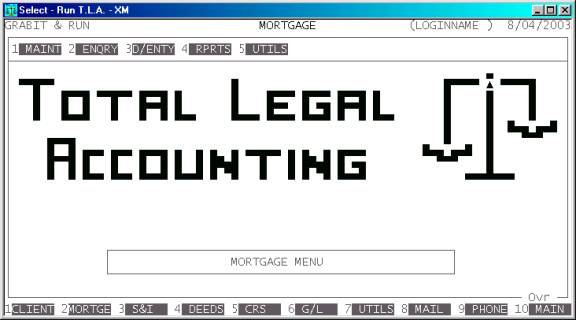Total
Legal Accounting 3
SECTION 2 - MORTGAGES MENU
The Mortgage Register has been designed to maintain
the static details of a Mortgage attached to a Client/Trust file. There can be only
one Mortgage File for any particular Client/Trust file. Also, it is usual to only
use that Client/Trust file for the purposes of the Mortgagor. Any kind of
transactions can be entered into the Trust card but only Trust transactions are
displayed or printed when making enquiries in the Mortgage sub-system. (I.e.
General transactions are ignored.)
Apart from the name of the Mortgagee, the card also
allows entry of up to 15 contributors. These must also have Client/Trust files.
This information is used for automatic dissection of TRUST TRANSFERS
from the Mortgagor's file. (See SECTION 2.3.1.)
The normal sequence of use for a Mortgagors file is
as follows:
1)
Receive
monies from the Mortgagee's file (TRUST RECEIPT).
2)
Pay
this to the Mortgagor. (TRUST CHEQUE).
3)
Receive
interest. (TRUST RECEIPT).
4)
Take
out charges. (FILE BILLS, TRUST TAKE-BACK, etc.)
5)
Transfer
the net interest payment to the Mortgagee's file (TRUST TRANSFER JOURNAL)
and the dissect this amount to the Contributors if necessary (also TRUST
TRANSFER JOURNALS). It is possible to do all of the TRUST TRANSFER
JOURNALS (in this part) via the special transaction type: MORTGAGE
TRANSFER JOURNAL.
6)
When
the loan is repaid, the balance is received into the Mortgagor's file (TRUST
RECEIPT) and the transferred to the Mortgagee (TRUST TRANSFER).
Various specific reports are available to facilitate
recovery of interest payments.
The MORTGAGE
MENU is accessed as item 2 or <F2> from the MAIN
MENU. On selecting this menu the following menu will be displayed:

To return to the MAIN MENU, press <ESC>.
Fields
available on the MORTGAGE MASTER file.
Name Comments
MORTGAGOR'S FILE This is the file number of the Mortgagor's
Client/Trust file. It is up to 6 characters long. The Client/Trust card must
exist and cannot be deleted until the Mortgage file is deleted.
MORTGAGEE'S FILE This is the file number of the Mortgagee's
Client/Trust file. It is up to 6 characters long. The file must exist. This is
an intermediate file, as interest payments are finally transferred to the
contributor files, see below. This file is usually belongs to the practice
itself.
CONTRIBUTORS There are 15 entries here.
Each has the code of the Client/Trust file of the Contributor and the value of
the contribution. Each file must exist and the contribution must be greater
than zero. The sum of contributions should equal the PRINCIPAL SUM (see below). It is possible to have no contributors
entered here. In this case, the Mortgagee is the only contributor and this
section is left blank. It is also possible to enter a commission rate here for
each contributor. This is any value from 0.001% to 99.999. It represents the
agreed commission to be taken off any interest payments as they are dissected
to the contributors. The MORTGAGE TRANSFER program can do this
automatically. (See SECTION 1.3.1.) It is usual to
enter a penalty commission rate also. This is normally higher than the normal commission
rate and can be chosen when a MORTGAGE TRANSFER is made.
PRINCIPAL This is the original amount lent (Principal Sum). It
is must not be zero and should be equal to the sum of the contributions.
DATE LENT This is the starting date of the mortgage. I.e. when
the Principal Sum was lent.
DATE REPAYABLE This is the date the principal sum is repayable. It
must not be less than the date lent.
CHANGES Here you may enter up to two lines of changes. There
is space for both the new sum lent and the date it happened. There is no
provision for keeping track of any new repayable date as this tends to stay
constant.
ACCEPTABLE RATE (%) &
AMOUNT This is normal (lower) percentage interest rate of
the loan and the value it represents.
HIGHER RATE (%) &
AMOUNT This is
the penalty (higher) interest rate of the loan and the value it represents.
RESTS This is a documentary entry describing the rests in
interest payments.
PERIOD This is a single letter representing the period of
interest payments. The options are: M for monthly payments, Q for quarterly payments, H for Half-yearly payments
and Y for yearly payments.
SECURITY ADD This contains the address of the Mortgagees property.
TITLE - VOLUME &
FOLIO There are four groups of entries here. Each has two
spaces for a Volume & Folio number, respectively. Each field is five
characters field wide. Thus you can document up to four Titles associated with
this Mortgage.
VALUATION This is estimated dollar value of the security.
ESTABLISHED BY This contains the name of the valuer.
REGN. NO This is a 10 character field containing details of
the Registration or Dealing number.
UNSEC. PARTICULARS If the mortgage is unsecured, the particulars must
be entered here.
MORTGAGE TYPE Here you enter which type of Mortgage this is. Eg.
First, Second, etc.
INSURANCE CO.NAME Here you enter the name of the insurance company
insuring the property or loan.
AMOUNT OF COVER Here you enter the value of the insurance cover.
DUE DATE This is the due date of the insurance policy.
POLICY NUMBER This is the number of the insurance policy.
DEED PACKET NO. Here you enter the Deed Packet Number associated with
this Mortgage.
Apart
from these fields, you can also use the function keys to access several
free-format fields.
NOTE (<F4>) This is a field that allows you to attach a comment to the account.
For instance, you might use this to store details of a dispute.
COLLAT (<F6>) This is a field that allows you to list any special collateral
information.